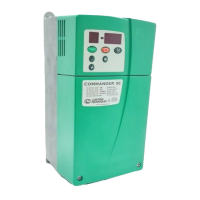10 Commander SE Advanced User Guide
Issue Number: 4
1.3 ANSI Protocol Description
Data is transmitted at a fixed speed or baud rate in the form of a character. A character is comprised of seven bits, and the
baud rate represents the data transmission rate in bits/second.
In order for a data receiver to recognise valid data, a frame is placed around each character. This frame contains a start bit, a
stop bit, and a parity bit. Without this frame, the receiver would be unable to synchronise itself with the transmitted data, as
the data is asynchronous.
A frame is shown here:
The frame consists of 10 bits:
• 1 start bit, followed by
• 7 data bits (starting with the least significant bit (i.e. lsb - bit 0) and ending with the most significant bit (i.e. msb - bit 6)),
followed by
• 1 even parity bit, followed by
• 1 stop bit
The parity bit is used by the data receiver to check the integrity of the 7 data bits it has received.
The 7 data bits are called a character and comprise the low ASCII set. The ASCII character set comprises 128 characters
decimally numbered from 0 to 127. The first 32 (0 to 31) characters in the ASCII set (hexadecimal 00H to 01FH) are used to
represent special control codes. Each control code has a particular meaning (e.g. ASCII character 02 H is called 'STX' the
'start of text').
A message consists of a group of frames or characters. These characters consist of the following types which are used to
construct the different types of messages:
• Control characters
• Address characters
• Parameter characters
• Data characters
• Block Checksum character
These character types are described below.
Control characters
Commands and requests are sent to the drive in the form of a set of characters, including control characters as a message
packet. Each message is started with a special control character, and may contain further control characters. A list of all the
relevant control characters in the ANSI protocol used when sending a message, and receiving is as follows:
Address characters
Each drive on an ANSI communications serial link must be given a unique identity or address so that only one target drive will
respond to a transmitted message. This serial address comprises two parts:
• The Group Address which is the first digit of the 2 digit address, and
• The Unit Address which is the second digit.
Both the group address and unit address have a range of 1 to 9. A group or unit address of 0 is not allowed (i.e. addresses
01, 10, 20, etc. are invalid). The reason for this is that drives can be grouped together (up to 9 units per group), and a
particular message with an address containing 0 can be sent to all units of the particular group. To address a particular group,
the unit address of zero (0) is used, for example, to address all units of group 6 the full address is 60.
An additional feature of the ANSI protocol is that a message can be sent to all units of all groups simultaneously using the
address 00. For example, the address 00 can be used to send a frequency/speed command to all the drives which are
mechanically coupled together driving a conveyor. All the drives will then change frequency/speed simultaneously.
ASCII 7-bit character (Low ASCII set)
Least significant Hexadecimal digit
Most significant Hexadecimal digit
(3 bits only)
Start bit Seven data bits
Even
Parity bit
Stop bit
0
bit 0
(lsb)
bit 1 bit 2 bit 3 bit 4 bit 5
bit 6
(msb)
(0 or 1) 1
1st bit 2nd bit 3rd bit 4th bit 5th bit 6th bit 7th bit 8th bit 9th bit 10th bit
Character Meaning
ASCII code
(2-digit
Hexadecimal)
Control Character on
Computer Keyboard
EOT
End of Transmission -
Reset - prepare for new message
04 Control-D
ENQ Enquiry - interrogating a ‘drive’ 05 Control-E
STX Start of Text (or data) 02 Control-B
ETX End of Text (or data) 03 Control-C
ACK Acknowledge (message accepted) 06 Control-F
NAK Negative acknowledge (message not accepted) 15 Control-U
BS Backspace 08 Control-H

